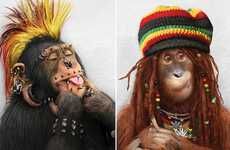
Annie Drew Paints One Pixel at a Time Using a Matchstick
boom chicky boom — November 25, 2009 — Art & Design
References: telegraph & zandavisitor
What started out as a piece of wildlife art in mosaic tiles, morphed into a new painting technique that self-taught artist Annie Drew calls pixelation painting. The technique took over a year for her to perfect, which when applied resembles a pixelated photograph.
To achieve this unique effect, Annie Drew painted about 70,000 dots in 40 colors with a hardwood stick just a bit bigger than a matchstick. The painting of the giant gorilla, which she entitled 'Silverback,' took about 2 weeks to complete.
After all that work, Annie Drew graciously donated the one meter square painting to raise funds for wildlife charity Paignton Zoo Environmental Park in the UK.
To achieve this unique effect, Annie Drew painted about 70,000 dots in 40 colors with a hardwood stick just a bit bigger than a matchstick. The painting of the giant gorilla, which she entitled 'Silverback,' took about 2 weeks to complete.
After all that work, Annie Drew graciously donated the one meter square painting to raise funds for wildlife charity Paignton Zoo Environmental Park in the UK.
Trend Themes
1. Pixelation Painting - The pixelation painting technique, developed by Annie Drew, offers a unique and visually captivating art form by using the pixelated effect of mosaic tiles.
2. Self-taught Artistry - Annie Drew's self-taught artistry demonstrates the potential of individuals to create innovative techniques and push creative boundaries without formal training.
3. Charitable Art - The act of donating artwork for charitable purposes showcases the power of art to make a positive impact and raise funds for important causes.
Industry Implications
1. Art - The art industry can explore the use of pixelation painting as a distinct and visually arresting art form, attracting new audiences and creating unique art experiences.
2. Education - The self-taught artistry of Annie Drew highlights the potential for educational institutions to embrace unconventional methods of learning and encourage individuals to explore their creative talents.
3. Charity - The intersection of art and charity presents an opportunity for nonprofit organizations to engage with artists and leverage their creativity to generate funds and raise awareness for important causes.
3.9
Score
Popularity
Activity
Freshness























